Business Ethics Self-Reflection
VerifiedAdded on 2020/03/16
|5
|1321
|117
Essay
AI Summary
This essay explores the concept of self-reflection in the context of business ethics, emphasizing the importance of accountability and ethical leadership. It analyzes various case studies, including the responsibilities of zoo management and the implications of a robbery, to illustrate how ethical decision-making impacts individuals and organizations. The author reflects on personal leadership qualities and the necessity of adhering to ethical standards in professional settings, ultimately highlighting the role of ethics in fostering a responsible corporate culture.
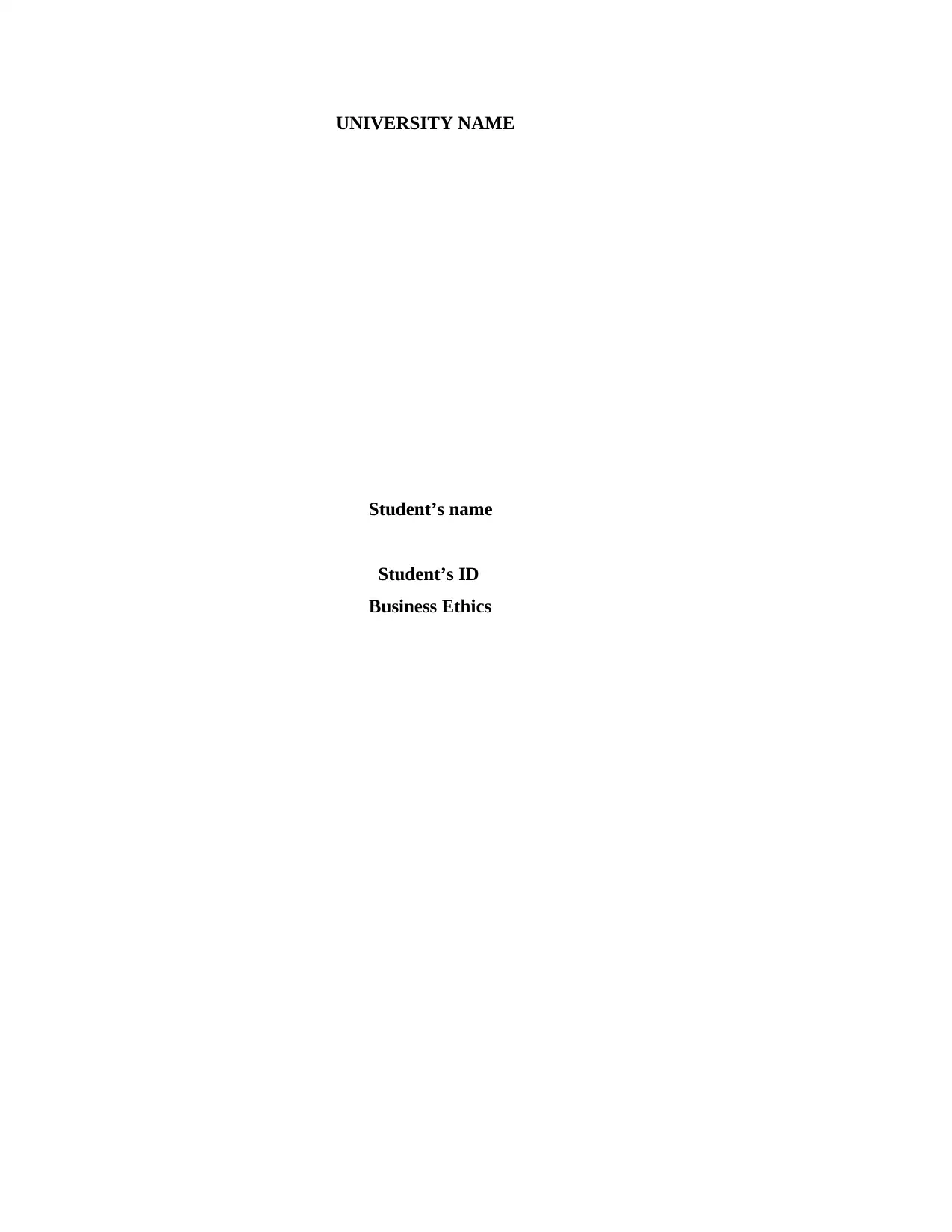
UNIVERSITY NAME
Student’s name
Student’s ID
Business Ethics
Student’s name
Student’s ID
Business Ethics
Secure Best Marks with AI Grader
Need help grading? Try our AI Grader for instant feedback on your assignments.
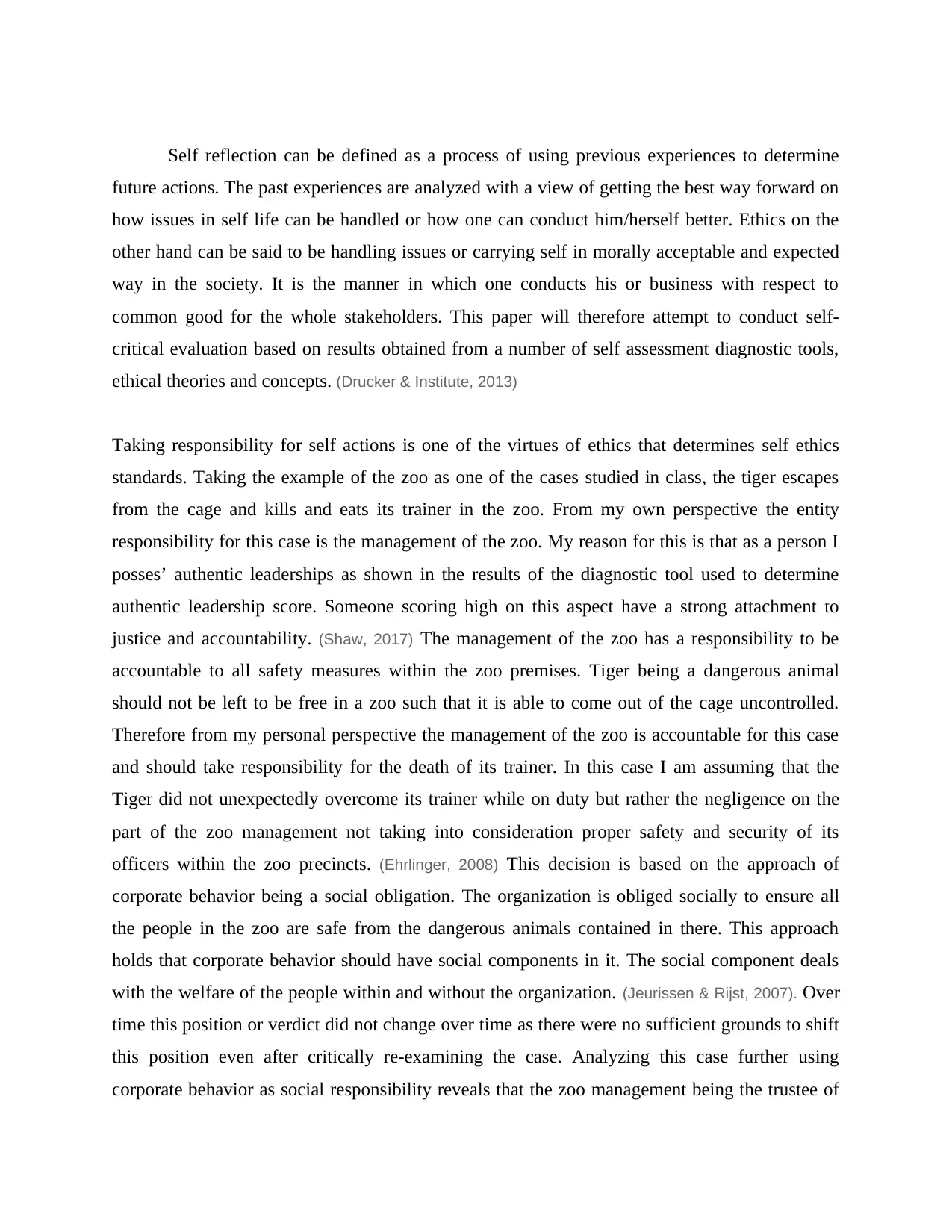
Self reflection can be defined as a process of using previous experiences to determine
future actions. The past experiences are analyzed with a view of getting the best way forward on
how issues in self life can be handled or how one can conduct him/herself better. Ethics on the
other hand can be said to be handling issues or carrying self in morally acceptable and expected
way in the society. It is the manner in which one conducts his or business with respect to
common good for the whole stakeholders. This paper will therefore attempt to conduct self-
critical evaluation based on results obtained from a number of self assessment diagnostic tools,
ethical theories and concepts. (Drucker & Institute, 2013)
Taking responsibility for self actions is one of the virtues of ethics that determines self ethics
standards. Taking the example of the zoo as one of the cases studied in class, the tiger escapes
from the cage and kills and eats its trainer in the zoo. From my own perspective the entity
responsibility for this case is the management of the zoo. My reason for this is that as a person I
posses’ authentic leaderships as shown in the results of the diagnostic tool used to determine
authentic leadership score. Someone scoring high on this aspect have a strong attachment to
justice and accountability. (Shaw, 2017) The management of the zoo has a responsibility to be
accountable to all safety measures within the zoo premises. Tiger being a dangerous animal
should not be left to be free in a zoo such that it is able to come out of the cage uncontrolled.
Therefore from my personal perspective the management of the zoo is accountable for this case
and should take responsibility for the death of its trainer. In this case I am assuming that the
Tiger did not unexpectedly overcome its trainer while on duty but rather the negligence on the
part of the zoo management not taking into consideration proper safety and security of its
officers within the zoo precincts. (Ehrlinger, 2008) This decision is based on the approach of
corporate behavior being a social obligation. The organization is obliged socially to ensure all
the people in the zoo are safe from the dangerous animals contained in there. This approach
holds that corporate behavior should have social components in it. The social component deals
with the welfare of the people within and without the organization. (Jeurissen & Rijst, 2007). Over
time this position or verdict did not change over time as there were no sufficient grounds to shift
this position even after critically re-examining the case. Analyzing this case further using
corporate behavior as social responsibility reveals that the zoo management being the trustee of
future actions. The past experiences are analyzed with a view of getting the best way forward on
how issues in self life can be handled or how one can conduct him/herself better. Ethics on the
other hand can be said to be handling issues or carrying self in morally acceptable and expected
way in the society. It is the manner in which one conducts his or business with respect to
common good for the whole stakeholders. This paper will therefore attempt to conduct self-
critical evaluation based on results obtained from a number of self assessment diagnostic tools,
ethical theories and concepts. (Drucker & Institute, 2013)
Taking responsibility for self actions is one of the virtues of ethics that determines self ethics
standards. Taking the example of the zoo as one of the cases studied in class, the tiger escapes
from the cage and kills and eats its trainer in the zoo. From my own perspective the entity
responsibility for this case is the management of the zoo. My reason for this is that as a person I
posses’ authentic leaderships as shown in the results of the diagnostic tool used to determine
authentic leadership score. Someone scoring high on this aspect have a strong attachment to
justice and accountability. (Shaw, 2017) The management of the zoo has a responsibility to be
accountable to all safety measures within the zoo premises. Tiger being a dangerous animal
should not be left to be free in a zoo such that it is able to come out of the cage uncontrolled.
Therefore from my personal perspective the management of the zoo is accountable for this case
and should take responsibility for the death of its trainer. In this case I am assuming that the
Tiger did not unexpectedly overcome its trainer while on duty but rather the negligence on the
part of the zoo management not taking into consideration proper safety and security of its
officers within the zoo precincts. (Ehrlinger, 2008) This decision is based on the approach of
corporate behavior being a social obligation. The organization is obliged socially to ensure all
the people in the zoo are safe from the dangerous animals contained in there. This approach
holds that corporate behavior should have social components in it. The social component deals
with the welfare of the people within and without the organization. (Jeurissen & Rijst, 2007). Over
time this position or verdict did not change over time as there were no sufficient grounds to shift
this position even after critically re-examining the case. Analyzing this case further using
corporate behavior as social responsibility reveals that the zoo management being the trustee of
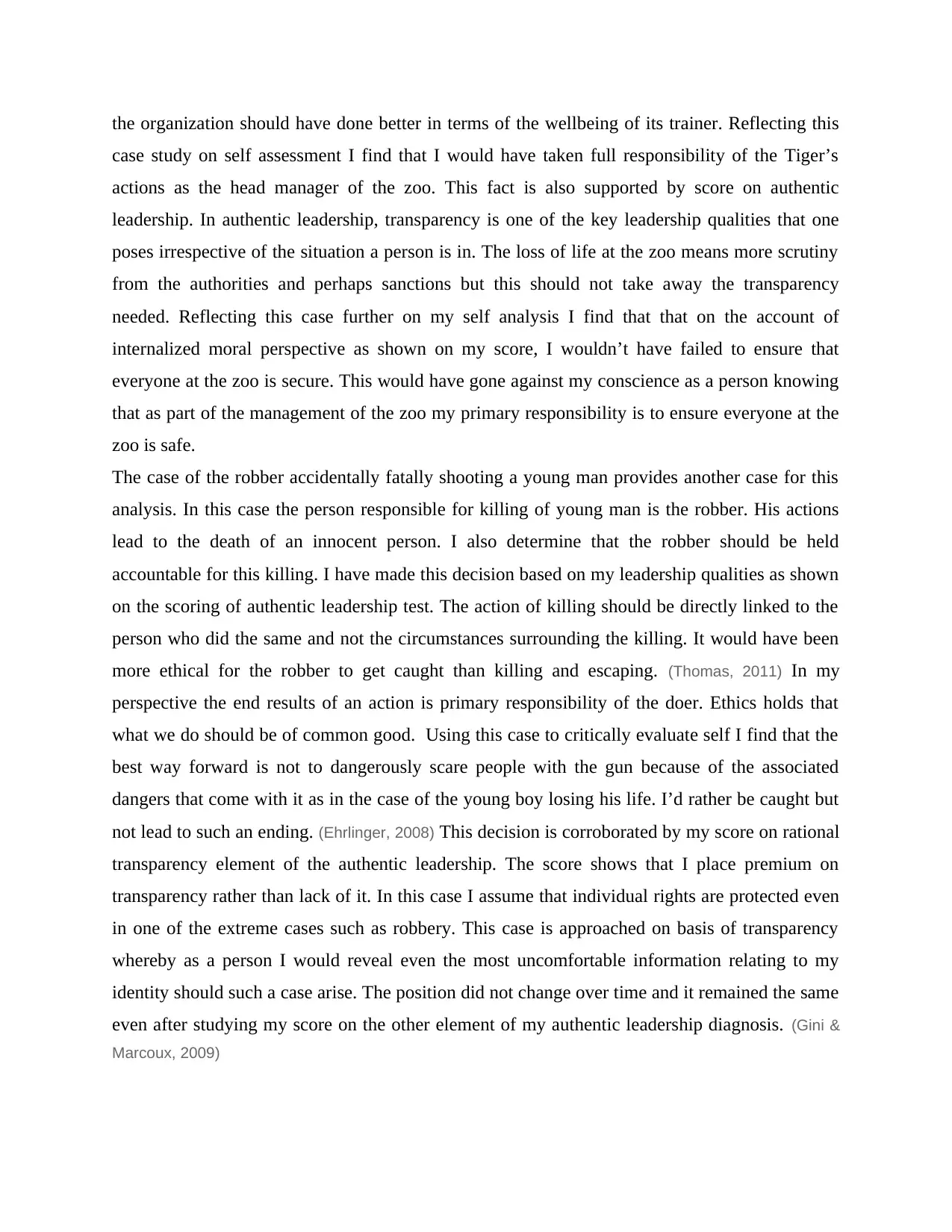
the organization should have done better in terms of the wellbeing of its trainer. Reflecting this
case study on self assessment I find that I would have taken full responsibility of the Tiger’s
actions as the head manager of the zoo. This fact is also supported by score on authentic
leadership. In authentic leadership, transparency is one of the key leadership qualities that one
poses irrespective of the situation a person is in. The loss of life at the zoo means more scrutiny
from the authorities and perhaps sanctions but this should not take away the transparency
needed. Reflecting this case further on my self analysis I find that that on the account of
internalized moral perspective as shown on my score, I wouldn’t have failed to ensure that
everyone at the zoo is secure. This would have gone against my conscience as a person knowing
that as part of the management of the zoo my primary responsibility is to ensure everyone at the
zoo is safe.
The case of the robber accidentally fatally shooting a young man provides another case for this
analysis. In this case the person responsible for killing of young man is the robber. His actions
lead to the death of an innocent person. I also determine that the robber should be held
accountable for this killing. I have made this decision based on my leadership qualities as shown
on the scoring of authentic leadership test. The action of killing should be directly linked to the
person who did the same and not the circumstances surrounding the killing. It would have been
more ethical for the robber to get caught than killing and escaping. (Thomas, 2011) In my
perspective the end results of an action is primary responsibility of the doer. Ethics holds that
what we do should be of common good. Using this case to critically evaluate self I find that the
best way forward is not to dangerously scare people with the gun because of the associated
dangers that come with it as in the case of the young boy losing his life. I’d rather be caught but
not lead to such an ending. (Ehrlinger, 2008) This decision is corroborated by my score on rational
transparency element of the authentic leadership. The score shows that I place premium on
transparency rather than lack of it. In this case I assume that individual rights are protected even
in one of the extreme cases such as robbery. This case is approached on basis of transparency
whereby as a person I would reveal even the most uncomfortable information relating to my
identity should such a case arise. The position did not change over time and it remained the same
even after studying my score on the other element of my authentic leadership diagnosis. (Gini &
Marcoux, 2009)
case study on self assessment I find that I would have taken full responsibility of the Tiger’s
actions as the head manager of the zoo. This fact is also supported by score on authentic
leadership. In authentic leadership, transparency is one of the key leadership qualities that one
poses irrespective of the situation a person is in. The loss of life at the zoo means more scrutiny
from the authorities and perhaps sanctions but this should not take away the transparency
needed. Reflecting this case further on my self analysis I find that that on the account of
internalized moral perspective as shown on my score, I wouldn’t have failed to ensure that
everyone at the zoo is secure. This would have gone against my conscience as a person knowing
that as part of the management of the zoo my primary responsibility is to ensure everyone at the
zoo is safe.
The case of the robber accidentally fatally shooting a young man provides another case for this
analysis. In this case the person responsible for killing of young man is the robber. His actions
lead to the death of an innocent person. I also determine that the robber should be held
accountable for this killing. I have made this decision based on my leadership qualities as shown
on the scoring of authentic leadership test. The action of killing should be directly linked to the
person who did the same and not the circumstances surrounding the killing. It would have been
more ethical for the robber to get caught than killing and escaping. (Thomas, 2011) In my
perspective the end results of an action is primary responsibility of the doer. Ethics holds that
what we do should be of common good. Using this case to critically evaluate self I find that the
best way forward is not to dangerously scare people with the gun because of the associated
dangers that come with it as in the case of the young boy losing his life. I’d rather be caught but
not lead to such an ending. (Ehrlinger, 2008) This decision is corroborated by my score on rational
transparency element of the authentic leadership. The score shows that I place premium on
transparency rather than lack of it. In this case I assume that individual rights are protected even
in one of the extreme cases such as robbery. This case is approached on basis of transparency
whereby as a person I would reveal even the most uncomfortable information relating to my
identity should such a case arise. The position did not change over time and it remained the same
even after studying my score on the other element of my authentic leadership diagnosis. (Gini &
Marcoux, 2009)
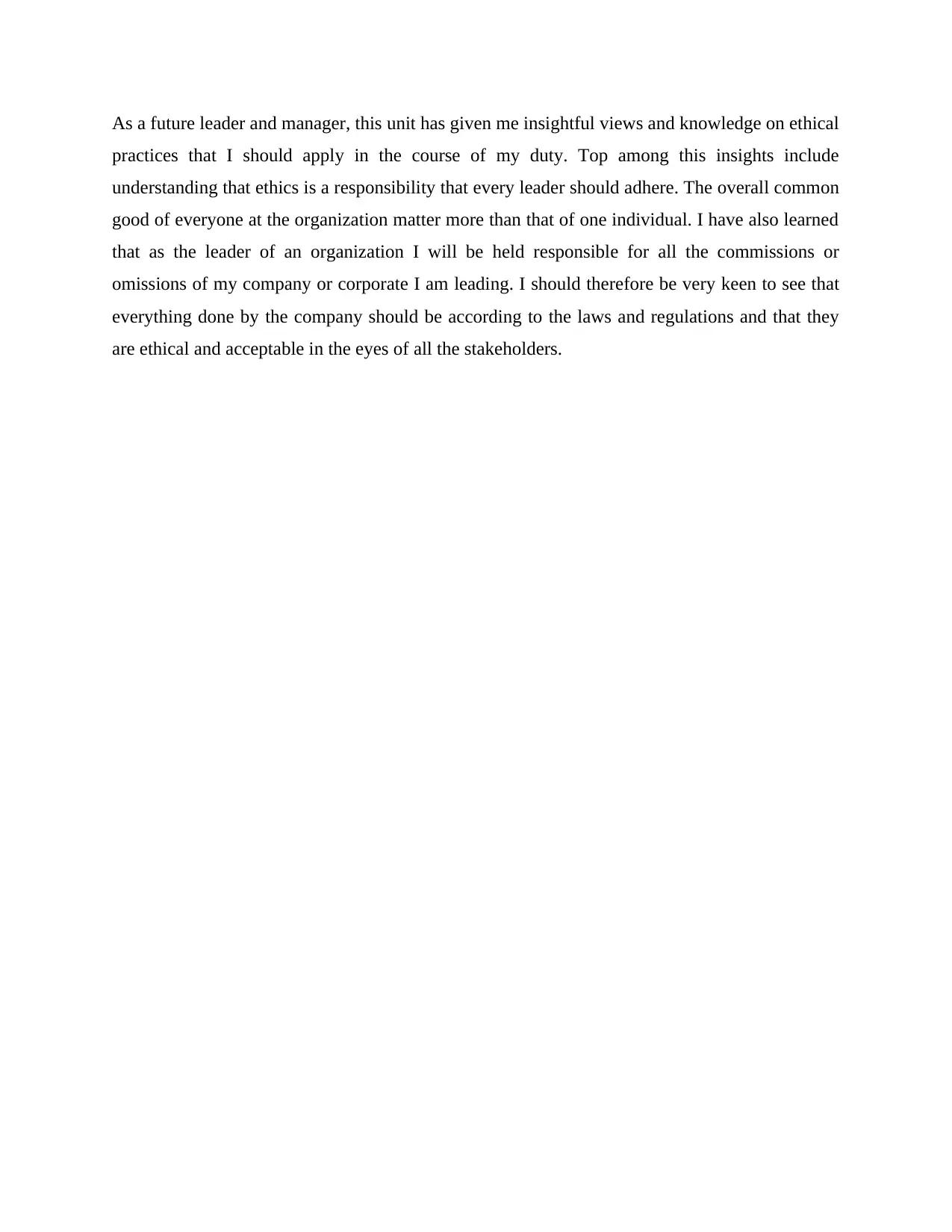
As a future leader and manager, this unit has given me insightful views and knowledge on ethical
practices that I should apply in the course of my duty. Top among this insights include
understanding that ethics is a responsibility that every leader should adhere. The overall common
good of everyone at the organization matter more than that of one individual. I have also learned
that as the leader of an organization I will be held responsible for all the commissions or
omissions of my company or corporate I am leading. I should therefore be very keen to see that
everything done by the company should be according to the laws and regulations and that they
are ethical and acceptable in the eyes of all the stakeholders.
practices that I should apply in the course of my duty. Top among this insights include
understanding that ethics is a responsibility that every leader should adhere. The overall common
good of everyone at the organization matter more than that of one individual. I have also learned
that as the leader of an organization I will be held responsible for all the commissions or
omissions of my company or corporate I am leading. I should therefore be very keen to see that
everything done by the company should be according to the laws and regulations and that they
are ethical and acceptable in the eyes of all the stakeholders.
Secure Best Marks with AI Grader
Need help grading? Try our AI Grader for instant feedback on your assignments.
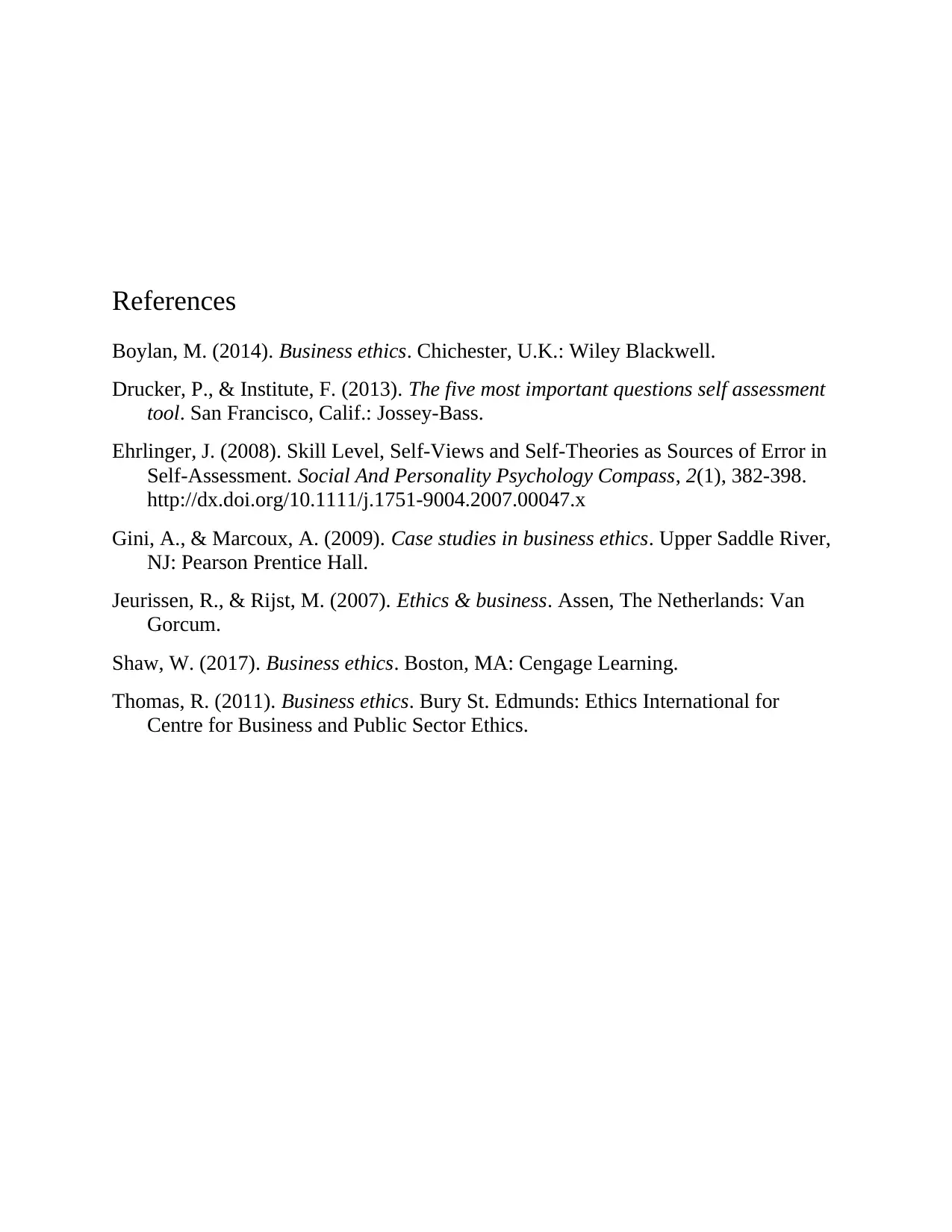
References
Boylan, M. (2014). Business ethics. Chichester, U.K.: Wiley Blackwell.
Drucker, P., & Institute, F. (2013). The five most important questions self assessment
tool. San Francisco, Calif.: Jossey-Bass.
Ehrlinger, J. (2008). Skill Level, Self-Views and Self-Theories as Sources of Error in
Self-Assessment. Social And Personality Psychology Compass, 2(1), 382-398.
http://dx.doi.org/10.1111/j.1751-9004.2007.00047.x
Gini, A., & Marcoux, A. (2009). Case studies in business ethics. Upper Saddle River,
NJ: Pearson Prentice Hall.
Jeurissen, R., & Rijst, M. (2007). Ethics & business. Assen, The Netherlands: Van
Gorcum.
Shaw, W. (2017). Business ethics. Boston, MA: Cengage Learning.
Thomas, R. (2011). Business ethics. Bury St. Edmunds: Ethics International for
Centre for Business and Public Sector Ethics.
Boylan, M. (2014). Business ethics. Chichester, U.K.: Wiley Blackwell.
Drucker, P., & Institute, F. (2013). The five most important questions self assessment
tool. San Francisco, Calif.: Jossey-Bass.
Ehrlinger, J. (2008). Skill Level, Self-Views and Self-Theories as Sources of Error in
Self-Assessment. Social And Personality Psychology Compass, 2(1), 382-398.
http://dx.doi.org/10.1111/j.1751-9004.2007.00047.x
Gini, A., & Marcoux, A. (2009). Case studies in business ethics. Upper Saddle River,
NJ: Pearson Prentice Hall.
Jeurissen, R., & Rijst, M. (2007). Ethics & business. Assen, The Netherlands: Van
Gorcum.
Shaw, W. (2017). Business ethics. Boston, MA: Cengage Learning.
Thomas, R. (2011). Business ethics. Bury St. Edmunds: Ethics International for
Centre for Business and Public Sector Ethics.
1 out of 5
Related Documents
Your All-in-One AI-Powered Toolkit for Academic Success.
+13062052269
info@desklib.com
Available 24*7 on WhatsApp / Email
![[object Object]](/_next/static/media/star-bottom.7253800d.svg)
Unlock your academic potential
© 2024 | Zucol Services PVT LTD | All rights reserved.





